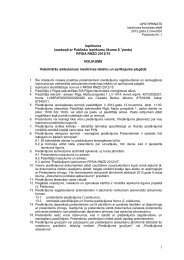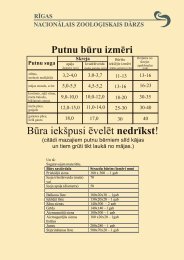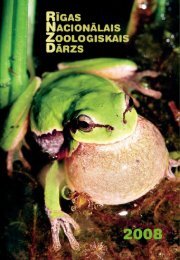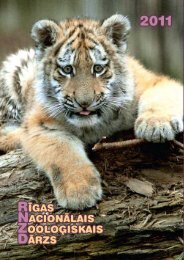Create successful ePaper yourself
Turn your PDF publications into a flip-book with our unique Google optimized e-Paper software.
2008, good results were attained using Fitoekol, an agent manufactured in Latvia for use in eradication<br />
of fungus infections in plants. In 2008 we started to experiment with use of medical herbs, notably garlic.<br />
Colleagues from Russia (Oleg Seletkin, Perm Zoo) suggested the use of live garlic plants in terrariums. The<br />
results exceeded any expectations – animal losses were reduced to minimum, and this method did not<br />
affect breeding negatively. Use of another herb, St John’s Wort Hypericum perforatum, gave good results,<br />
too. Ilze Dunce gave the presentation on use of medical plants during Bombina bombina LIFE project final<br />
conference in Germany. Currently the use of garlic is adopted by several other amphibian collections in<br />
Europe.<br />
Reptiles<br />
At the end of 2009, there were 63 species in Riga Zoo’s reptile collection. Four species bred in 2009,<br />
including Asian Water Dragons Physignathus cocincinus (17 young hatched in the incubator), Great Plated<br />
Lizards Gerrhosaurus major (3), Madagascar Giant Day Geckos Phelsuma madagascariensis (5) and Green<br />
Crested Basilisks Basiliscus plumifrons (19).<br />
Juvenile Nile Crocodile Crocodylus niloticus that was housed temporarily by the zoo in Tropical House<br />
grew well and became increasingly active, so we had to remove the animal from the exhibit to more safe<br />
accommodation in off-public premises. Search for a new home for the animal was started, and the end of<br />
the year brought good news that the young female crocodile will be welcome to Tropicario, Helsinki.<br />
The former Mississippi Alligator exhibit in Tropical House could be more convenient for keeping smaller<br />
crocodile species. On 20 October five young Dwarf Crocodiles Osteolaemus tetraspis were brought from<br />
Plzen Zoo.<br />
On 18 March 10 young Veiled Chameleons Chamaeleo calyptratus arrived from Lodz Zoo. That gave us<br />
a possibility to renew the species exhibit in Terrarium. Towards the end of the year all the three females<br />
started laying.<br />
Another additions to our reptile collection were three Asian ratsnake species and subspecies – Elaphe<br />
mandarina, E. porphyracea laticincta and E. porphyracea coxi.<br />
Birds<br />
At the end of 2009, there were 82 bird species in Riga Zoo’s collection. 13 species bred in 2009. The year<br />
was not very happy for our bird collection, though.<br />
Several prospective bird pairs were lost during 2009. Deaths included female Hamerkop Scopus umbretta<br />
(ovaritis and egg binding), female Great Grey Owl Strix nebulosa lapponica (metabolic problems) and male<br />
Hawk Owl Surnia ulula (the most probable cause was thyroid hyperfunction). The loss of Hawk Owl was<br />
especially disappointing as only a month ago a female for pair forming arrived from Monticello Breeding<br />
and Conservation Centre. Egg binding occurred to our female Laughing Kookaburra Dacelo novaeguineae,<br />
too, but it was possible to save the bird.<br />
Snowy Owl Nyctea scandiaca chicks were lost for the second time, most probably wild Marten activity<br />
was to blame. East Great Cormorant Phalacrocorax carbo sinensis nest colony was devastated by wild Fox. A<br />
Sulphur-crested Cockatoo Cacatua galerita chick hatched on 27 January but died due to trauma on 17 April,<br />
in the next day after fledging.<br />
During last years Turkey Vulture Cathartes aura ruficollis breeding went without success, too. Of two eggs<br />
laid in February one disappeared, and the chick from the second egg died after hatching. Two next eggs of<br />
March resulted in dead embryos. The last two eggs were laid in May and broken by parents later on.<br />
The breeding attempts of Cinereous Vultures Aegypius monachus were unsuccessful for the third breeding<br />
season. First egg, laid on 6 March, was broken by parents after 10 days of incubation. On 10 April the second<br />
egg was laid, but embryo died just before hatching.<br />
Stanley Cranes Anthropoides paradisea had two clutches but all four eggs proved to be unfertile. The two<br />
previous breeding attempts had given the same result. Our observations showed that most possibly the<br />
male was not successful in copulation. The bird not only has got a pinioned wing but also fails to respond<br />
to female calls.<br />
Common Crane Grus grus grus pair produced three eggs. Two of them were destroyed by female, the third<br />
embryo died after ca. 3 weeks of development.<br />
The year of 2009 brought pleasant events, too. Manchurian Cranes Grus japonensis produced another two<br />
chicks. Several birds were distributed to other collections. Two young of this year went to Bussolengo Zoo,<br />
two young cranes from previous year were sent to Overloon Zoo and Cleres Zoo respectively. Our second,<br />
22








